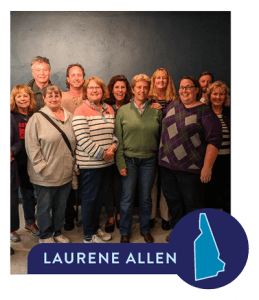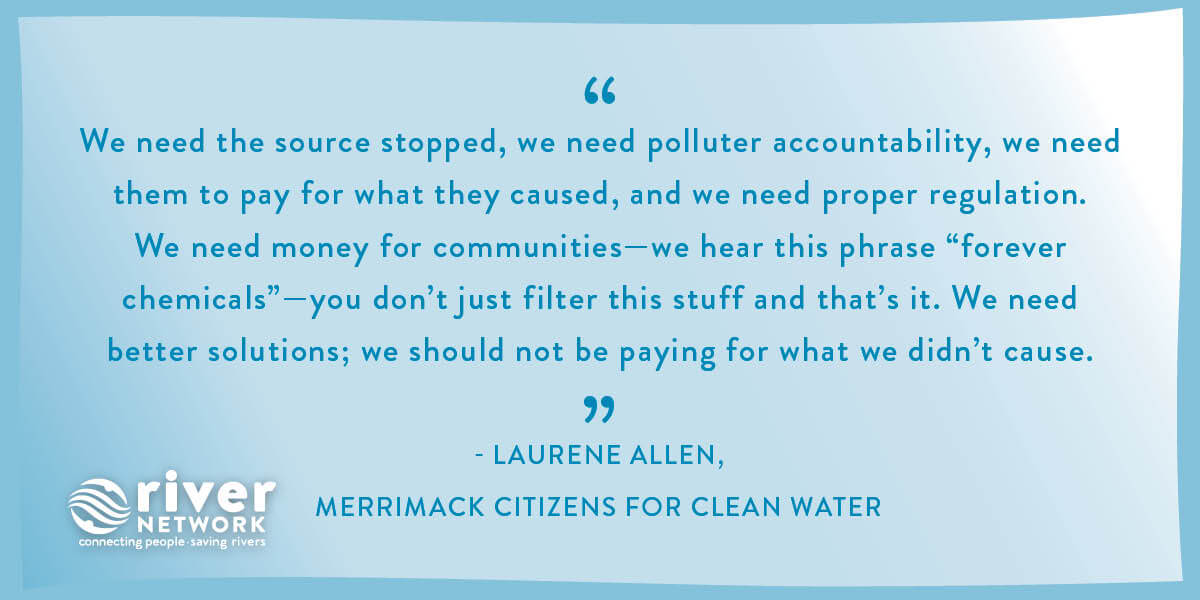Deep Dive: PFAS
Per- and polyfluoroalkyl substances (PFAS) are a large group of human-made chemicals. Often referred to as the “forever chemical,” PFAS do not breakdown easily and can accumulate over time, leading to serious health effects. PFAS can enter humans through food, water, and air. Reporting by the Union of Concerned Scientists reveal that manufacturers of PFAS have known—and hidden—the impact of PFOA on human and environmental health.
Lessons from New Hampshire
In New Hampshire, companies such as DuPont, 3M, and Chemours have manufactured or used PFAS extensively for decades. In 2016, high levels of PFAS were detected in drinking water wells in the state. In 2017, legislation was introduced (HB 485), to direct the Department of Environmental Services (DES) to adopt a state drinking water standard for perfluorochemicals. In 2018, SB 309 passed, which directed the DES to set maximum contaminant limits for public drinking water. As the rulemaking process progressed, clean water advocates heavily engaged in the public commenting period. However, a judge halted enforcement of the stricter standards after 3M sued the state, alleging that a comprehensive cost-benefit analysis had not been conducted. This lawsuit also delayed state testing of water systems for PFAS. In 2020, the New Hampshire legislature adopted the Department of Environmental Services’ drinking water standards as law through House Bill 1264, circumventing the rulemaking process. Subsequently, 3M and its co-plaintiffs voluntarily abandoned their suit. In an ongoing back and forth, 3M, Chemours, DuPont, and five other companies were subject to lawsuits levied by New Hampshire in 2019. According to a press release by DES, the lawsuits seek to “recover all costs to investigate, clean up, restore, treat, monitor, and otherwise respond to contamination of the State’s groundwater, surface water, fish, wildlife, marine resources, and other natural resources.” Both lawsuits are ongoing.
Key Policy Language
House Bill 1264 set the maximum contaminant levels of four perfluorochemicals in drinking water, established a fund and programs related to PFAS testing and clean up, requires insurance coverage for PFAS and PFC blood tests, and expanded the statute governing ambient groundwater quality standards. Specifically,
Maximum Contaminant Levels
(a) Perfluorooctanoic acid (PFOA): 12 parts per trillion.
(b) Perfluoroctanesulfonic acid (PFOS): 15 parts per trillion.
(c) Perfluorohexanesulfonic acid (PFHxS): 18 parts per trillion.
(d) Perfluorononanoic acid (PFNA): 11 parts per trillion.”
Funding for Testing and Treatment
“The department shall provide low interest loans to community water systems and non-profit, non-transient public water systems whose testing of untreated source water shows confirmed exceedance of the state maximum contaminant level for PFAS, for remediation efforts begun after September 30, 2019…. Loans may be made for up to the total cost of the project, after any responsible party’s contribution, addressing the contamination.”
“The department shall provide low interest loans to publicly-owned and non-profit wastewater and/or wastewater residual treatment or storage facilities that are required to treat effluent and residuals to achieve PFAS standards prior to discharge or disposal.”
“The department shall forgive up to 10 percent of the loan principal to community water systems and non-profit, non-transient non-community water systems using the same qualifying standards for forgiveness used in the drinking water state revolving loan program… [and] shall forgive up to 10 percent of the loan principal for publicly-owned and non-profit wastewater treatment facilities using the same qualifying standards for forgiveness used in the clean water state revolving loan program.”
“…Any remaining funds from judgments or settlements received by the state resulting from lawsuits against the manufacturers of PFAS shall be deposited into the drinking water and groundwater trust fund.”
“There is hereby established in the department the PFAS remediation loan fund which shall be maintained by the state treasurer in distinct and separate custody from all other funds… The sum of $50,000,000 is hereby appropriated to the department of environmental services for capital expenditures for the remediation of per- and polyfluoroalkyl substances in the state’s drinking water sources and waste water residuals.”
Perfluoroalkyls (PFAS) and Perfluorinated Compound (PFC) Blood Testing
“Each insurer that issues or renews any individual policy of accident or health insurance providing benefits for medical or hospital expenses, shall provide to certificate holders of such insurance, who are residents of this state, coverage for perfluoroalkyls (PFAS) and perfluorinated compound (PFC) blood testing. Benefits provided under this section shall not be subject to any greater co-payment, deductible, or coinsurance than any other similar benefits provided by the insurer.”
Ambient Groundwater Quality Standards
“The commissioner shall establish and adopt ambient groundwater quality standards for regulated contaminants which adversely affect human health or the environment. Ambient groundwater standards shall apply to all regulated contaminants which result from human operations or activities… The commissioner may adopt standards more stringent than federal maximum contaminant levels or health advisories if, accounting for an adequate margin of safety to protect human health at all life stages, including but not limited to pre-natal development, the commissioner determines federal standards are insufficient for protection of human health. Where such standards are established based upon health advisories that address cancer risks, the ambient groundwater quality standards shall be equivalent to that exposure which causes a lifetime exposure risk of one cancer in 1,000,000 exposed population.”
Advocacy and Implementation
In addition to New Hampshire, other northeastern states such as New Jersey, Vermont, and Maine adopted maximum contaminant levels for PFAS in drinking water in recent years. Public awareness of the widespread prevalence of the forever chemicals spurred calls to action from the town halls of small municipalities to state capitals to Washington, D.C. The story of one Merrimack, New Hampshire, resident highlights the power and impact of an informed citizenry.
 Leaders Emerge from Crisis
Leaders Emerge from Crisis
Laurene Allen is a licensed clinical social worker, and a co-founder of Merrimack Citizens for Clean Water. In March 2016, Merrimack residents learned that their water was contaminated by PFAS from a facility in town, Saint Gobain Performance Plastics. They had been consuming PFAS through their drinking water for at least two decades. During the initial community meetings that year, person after person shared stories of grappling with health conditions. Allen, who has lived in Merrimack since 1985, began asking questions, attending meetings, and educating herself and her community on the prevalence and effects of PFAS. She is one of the original founders of the National PFAS Contamination Coalition, composed of groups from around the country working on shared goals to test, monitor, regulate, and end source pollution of PFAS at state and national levels. Allen works with groups in New England states to conduct outreach and education to their legislators. She credits her background as a social worker for her keen ability to collaborate—including with ornery state legislators across the aisle and hesitant neighbors—to instigate change.
She explains, “I think, for a lot of residents, we’ve become real experts, that’s the phrase that you hear and it’s absolutely non-negotiable. If you look around, in many communities there’s a small group of people who often say, “Well, who else is going to do this?”
Merrimack Citizens for Clean Water’s goals include the implementation of more protective regulatory water standards combining all PFAS chemicals, improved communication from state agencies to impacted communities, and polluter responsibility and accountability.
Laurene Allen articulates that, “We need the source stopped, we need polluter accountability, we need them to pay for what they caused, and we need proper regulation. We need money for communities—we hear this phrase “forever chemicals”—you don’t just filter this stuff and that’s it. We need better solutions; we should not be paying for what we didn’t cause.”
 Merrimack Citizens for Clean Water developed strong relationships with state legislators, and brought them scientific information about maximum contaminant levels (MCLs) and the cumulative impacts of PFAS, as well as the personal testimonies of their constituents. Through their advocacy work, the organization helped to established the MCLs put forth in the rulemaking process initiated by Senate Bill 309 and finalized in House Bill 1264. They also fought for targeted goals that would directly assist affected residents, including insurance coverage for blood testing. Allen connects with scientific, academic, and legal professionals to communicate effectively around this complex topic. Natural Resources Defense Council (NRDC) and Silent Spring Institute both continue to contribute to the advocacy work in New Hampshire around public health and holding corporations responsible for pollution.
Merrimack Citizens for Clean Water developed strong relationships with state legislators, and brought them scientific information about maximum contaminant levels (MCLs) and the cumulative impacts of PFAS, as well as the personal testimonies of their constituents. Through their advocacy work, the organization helped to established the MCLs put forth in the rulemaking process initiated by Senate Bill 309 and finalized in House Bill 1264. They also fought for targeted goals that would directly assist affected residents, including insurance coverage for blood testing. Allen connects with scientific, academic, and legal professionals to communicate effectively around this complex topic. Natural Resources Defense Council (NRDC) and Silent Spring Institute both continue to contribute to the advocacy work in New Hampshire around public health and holding corporations responsible for pollution.
The Fight Against Large Corporations
Legal battles between chemical companies and states that have experienced contamination remain fraught. National environmental organizations play an important role assisting communities like Merrimack in these disputes. Conservation Law Foundation (CLF) and NRDC (Natural Resources Defense Council) filed a brief in the case in New Hampshire’s Supreme Court initiated by 3M in 2020, challenging key points put forth in the lawsuit. As the fate of the lawsuits brought against 3M, DuPont, and others by the state of New Hampshire remain unknown, other communities have won settlements, including in Hoosick Falls, NY.




